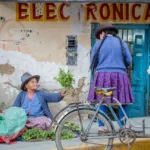“Peru’s Cusco: Unlock the Mysteries of Machu Picchu, the Majestic Inca Citadel in the Clouds.”
ROAMOPEDIA
Machu Picchu
Peru’s Cusco: Unlock the Mysteries of Machu Picchu, the Majestic Inca Citadel in the Clouds.
- Home
- /
- Country
- /
- Peru
- /
- City
- /
- Cusco
- / Peru’s Cusco: Unlock the Mysteries of Machu Picchu, the Majestic Inca Citadel in the Clouds.
Related
All related contents.
Related Posts
Peru’s Cusco: Sacsayhuaman Fortress – Where Inca Majesty Meets Breathtaking Views
Peru’s Trujillo – Journey Through Time: Discover the Enigmatic Huaca del Sol y Huaca de la Luna, Unraveling Moche Mysteries and Marvels.
Peru’s Cusco & Sacred Valley: Inca Treasures, Timeless Charm, and Cultural Wonders Awaiting Discovery
Discover the breathtaking beauty of Huaraz in Peru – a haven for adventure seekers.
Discover Lake Titicaca: Soaring Altitudes, Floating Islands, and Andean Legacies.
Discover the ancient wonder of Chan Chan in Trujillo, Peru – where the grand adobe legacy of the Chimu culture stands timeless.
Discover Peru’s Timeless Treasures: Lima’s Larco Museum – Where Pre-Columbian Art and History Come Alive
Miraflores: Coastal Bliss Meets Urban Excitement in Lima’s Heart
Colca Canyon, Arequipa, Peru: Explore the Depths of Beauty in a World of Awe-inspiring Landscapes and Adventure.
Discover the beauty of Arequipa, Peru’s ‘White City,’ and its stunning attractions including the Santa Catalina Monastery, Colca Canyon, Plaza de Armas, and Yanahuara.
Discover the treasures of ancient civilizations in Trujillo, Peru.
Discover the vibrant culture and history of Ayacucho, Peru.
Discover the natural wonders of Peru’s Paracas: a coastal paradise of wildlife, landscapes, and beaches.
Experience the vibrant fusion of history, culture, and gastronomy in Lima, Peru.
Discover the wonders of the Peruvian Amazon in Iquitos.

The Ultimate Peru Travel Guide: From Machu Picchu to the Amazon
Discover the vibrant hues and storied past of Santa Catalina Monastery: Arequipa’s 16th-century treasure.
Discover the mysteries of ancient Peru in Nazca.
Uncover Nature’s Secrets: Iquitos, Peru – Your Gateway to the Enchanting Amazon Rainforest
Discover the legacy of the Incas in the heart of Cusco, Peru.
Discover Peru’s Qorikancha in Cusco: A Timeless Testament to Inca Brilliance and Spanish Legacy
Peru’s Huaraz: Cordillera Blanca – Unleash Your Adventure in the Heart of the Andes
Peru’s Huacachina: Ica’s Dazzling Desert Oasis for Thrilling Sandboarding and Dune Buggy Adventures
Unlock the enigma of the Nazca Lines: Peru’s desert canvas unveiled from the skies.
Explore the ancient wonders of Peru’s Puno region, where history and culture come to life.
Related
Related contents and articles.
Related Posts
- Print
- Share
- +-Font Size